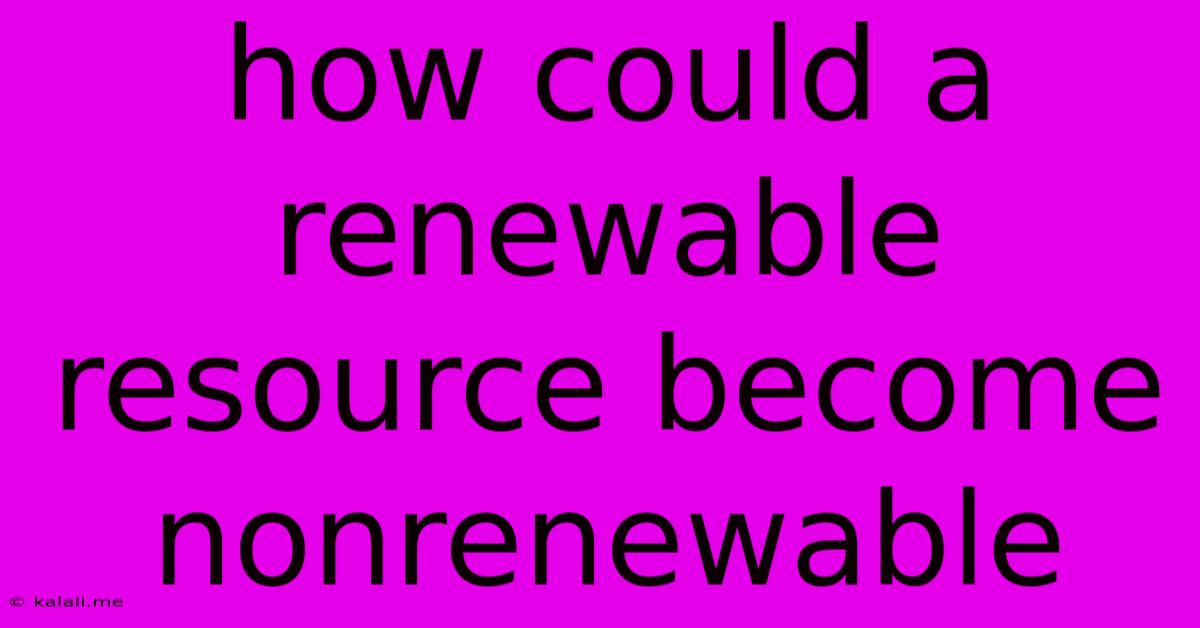How Could A Renewable Resource Become Nonrenewable
Kalali
May 10, 2025 · 4 min read

Table of Contents
How Could a Renewable Resource Become Non-Renewable?
Meta Description: Renewable resources, by definition, replenish naturally. But unsustainable practices can deplete them faster than they regenerate, effectively making them non-renewable. This article explores how this depletion occurs across various resource types.
Renewable resources, like sunlight, wind, and water, are naturally replenished over a relatively short period. This inherent characteristic distinguishes them from non-renewable resources such as fossil fuels, which take millions of years to form. However, the seemingly endless supply of some renewable resources can be jeopardized by human activities, leading to a situation where they become effectively non-renewable. This depletion isn't about the resource itself ceasing to exist, but rather about its rate of consumption exceeding its rate of regeneration.
This article will delve into the specific scenarios that can transform renewable resources into limited, effectively non-renewable, assets.
The Overexploitation of Renewable Resources
The primary mechanism by which a renewable resource becomes non-renewable is overexploitation. This occurs when the rate of extraction or consumption surpasses the rate of natural replenishment. This imbalance creates a deficit, steadily depleting the resource. Consider these examples:
-
Groundwater depletion: Groundwater, a crucial renewable resource, replenishes through rainfall and snowmelt. However, excessive pumping for agriculture, industry, and domestic use in many regions has led to significant depletion of aquifers. In some areas, the extraction rate far outpaces the recharge rate, effectively turning this renewable resource into a finite one. This leads to issues like land subsidence and saltwater intrusion into freshwater aquifers.
-
Overfishing: Fish populations, a renewable resource if managed correctly, are highly susceptible to overfishing. Unsustainable fishing practices, including the use of destructive gear and ignoring catch limits, can deplete fish stocks to dangerously low levels, hindering their ability to recover and reproduce. This leads to ecological imbalances and impacts food security.
-
Deforestation and soil erosion: Forests are renewable resources, capable of regenerating over time if managed sustainably. However, deforestation for agriculture, logging, and urbanization destroys habitats and leads to soil erosion. This erosion reduces the land's ability to support forest regeneration, diminishing the long-term renewability of the forest ecosystem. The loss of topsoil also impacts other renewable resources like groundwater, making it less capable of replenishment.
-
Unsustainable Biomass Harvesting: Biomass, such as wood and agricultural residues, is a renewable energy source. However, harvesting biomass at a rate faster than its regeneration can lead to deforestation, soil degradation, and biodiversity loss, effectively compromising its long-term sustainability. This also impacts carbon sequestration capacity, further exacerbating climate change.
The Role of Pollution in Resource Degradation
Pollution is another factor that can severely compromise the renewability of resources. Contamination can render a renewable resource unusable, effectively reducing its availability:
-
Water pollution: Pollutants from industrial discharge, agricultural runoff, and sewage can contaminate water sources, rendering them unfit for drinking, irrigation, or other uses. This pollution can severely hamper the renewability of water resources, even if the water itself is still physically present. Cleaning polluted water often requires significant energy and resources, adding to the environmental burden.
-
Soil contamination: Industrial waste, pesticides, and heavy metals can contaminate soil, reducing its fertility and ability to support plant life. This degradation hinders the renewal of soil resources, reducing agricultural productivity and threatening food security. Remediating contaminated soil is a complex and costly process.
The Importance of Sustainable Practices
To prevent renewable resources from becoming non-renewable, sustainable practices are crucial. This involves careful management of resource extraction, pollution control, and conservation efforts. Examples include:
- Implementing responsible fishing practices: Enforcing catch limits, protecting breeding grounds, and using sustainable fishing gear are crucial for maintaining healthy fish populations.
- Promoting sustainable agriculture: Techniques like crop rotation, cover cropping, and reduced tillage minimize soil erosion and maintain soil fertility.
- Protecting and restoring forests: Reforestation projects and sustainable logging practices help maintain forest cover and biodiversity.
- Investing in renewable energy: Transitioning to renewable energy sources like solar and wind power reduces reliance on fossil fuels and mitigates climate change.
- Improving water management: Efficient irrigation techniques, rainwater harvesting, and wastewater treatment help conserve and protect water resources.
By embracing sustainable practices and responsible resource management, we can ensure the long-term availability of these vital resources for future generations. Failing to do so risks transforming our planet's renewable assets into finite and ultimately depleted resources.
Latest Posts
Latest Posts
-
Why Did The Kangaroo See A Psychiatrist
Jul 06, 2025
-
How Long Would It Take To Walk To China
Jul 06, 2025
-
Step Up To The Streets Final Dance
Jul 06, 2025
-
How Many Grams Is Half An Oz
Jul 06, 2025
-
How Much Is 10 Quarters In Dollars
Jul 06, 2025
Related Post
Thank you for visiting our website which covers about How Could A Renewable Resource Become Nonrenewable . We hope the information provided has been useful to you. Feel free to contact us if you have any questions or need further assistance. See you next time and don't miss to bookmark.